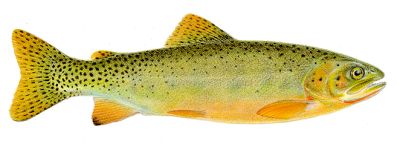
The River Cutthroat Trout

|
The
West Slope cutthroat (sometimes called the Montana Blackspot)
has a heavily speckled tail and characteristic red slashes on
the throat. River cutthroat tend to be much smaller than river
rainbow trout. |
Most cutthroat systems have two separate populations of Salmo clarki, each with its own ecological niche. One inhabits the main river, the other resides in the smaller feeder streams and head waters. Those that inhabit the main river are much larger than the smaller stream residents: the main river usually produces more food and has a more constant environment in terms of temperature and flow, so it promotes a more rapid growth rate.
In the Columbia and Snake Rivers, for example, there are large numbers of four-year-old cutthroats measuring 16 inches and more, and weighing well in excess of the pound mark. In the high headwaters and feeder streams, small rough rocky streams set in pine forest and maple and alder woodland, the resident cutthroats at four years of age are often only six to eight inches in length and weigh in at three or four to the pound.
There is evidence that each of the populations within one river system remain separate, so the main river and the feeder streams may each be considered to have their own strain. When the main river cutthroat head upstream in the winter months to spawn during the spring in the smaller streams, they may spawn alongside the feeder stream trout. Often, however, the small-stream fish are separated by some barrier - a waterfall or dam - over which the big-river fish cannot pass, or the small-stream fish spawn a little later than those fish that have run upstream from the main river, or they spawn on different gravel beds. Soon after spawning, the trout from the main river tend to drop quickly downstream, and their fry often follow soon after emerging from the gravel redds. By contrast, the small-stream cutthroats tend to stay permanently close to their redds.
Many cutthroat river systems have been stocked with non-native trout, and the local strains have been lost. Where other forms of cutthroats have been introduced, they have interbred with the native cutthroats to produce a mongrel stock. Elsewhere, brown trout from Europe, or rainbow trout or brook trout (speckled char) from elsewhere in North America have ousted the native cutthroats from much of the river system. In some cases the introduced rainbows have hybridised with the native cutthroats, destroying the integrity of the local population.
Where the range of cutthroats overlaps naturally with the range of rainbow trout, the two may co-exist in the same river. Anglers fishing the big rivers of British Columbia, Washington State and Oregon often find that in the rough turbulent water at the neck of a pool the fly is taken by rainbow trout, while cutthroats are feeding a few yards downstream, where the flow slackens and the water deepens in the body of the pool. Where a rapid flow gushes through the centre of the pool, there may be rainbow trout; the cutthroats occupy the slow flow in a deep hole under the river bank.
Over the length of a river shared by wild stocks of cutthroats and rainbows, the rainbow trout often predominate in the lower reaches and the cutthroats upstream. So both species can find a separate niche; and where they do so they will not interbreed. Usually the cutthroats spawn earlier than the rainbows. And, possibly because they tend to be smaller than rainbow trout in the same river system, the, cutthroats move higher up the feeder streams and cut their redds in smaller gravel than the rainbow trout.

Colorado Cutthroat Salmo clarki pleuriticus

Rio Grande Cutthroat Salmo clarki virginalis
|
Above |
However, problems arise when rainbow trout are put into rivers which were formerly occupied only by cutthroats. In such waters, the main-river cutthroats will have taken the faster water lies that provide more food, while the smaller ones hold lies in the less productive feeder streams. When rainbow trout are introduced they compete with the cutthroats throughout the river, taking the prime lies from the bigger fish and devouring the smaller cutthroats. They will use any redd gravel to spawn, either interbreeding with the cutthroats or interfering with their breeding cycle by ousting the cutthroats from the better gravel and devouring their ova and fry.